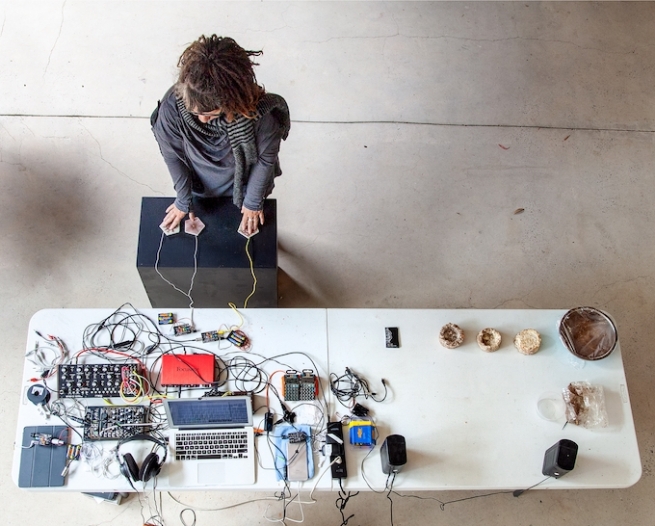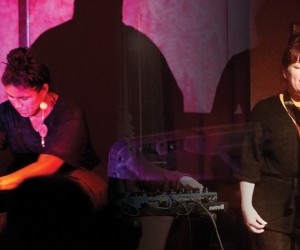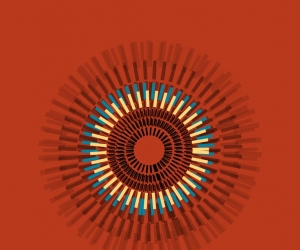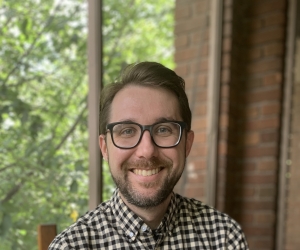
The lobby is cavernous and cool compared to the heat under the blazing mid-afternoon sun outside. It’s mid July, and I’m visiting Toronto’s Museum of Contemporary Art (MOCA) on a decidedly peculiar mission: to listen to music made by fungus. As part of the seventh edition of Vector Festival, Tosca Terán is staging a workshop on the biosonification of nonhuman collaborators. As I enter, it’s clear that I’m in the right place. I can hear a wavering tone emanating from the far end of the main floor. I head towards the drone, and join a dozen visitors clustered around a long table peppered with potted plants and mycelium (the vegetative part of fungus) forms, scattered piles of electronics and cables, and an array of semimodular synthesizers.
The monophonic synth voice sounds nasal and resonant as it slowly creeps up and down semitones. There are occasional pulses with a staccato rhythm and intermittent humming. It might be because the mix is wet with reverb, but my inner critic wants to ascribe these electrode-laden plants and mycelium with agency—clearly they are making overtures towards ambient music—but what I’m hearing is too oblique to lump in with the pristine melodies often associated with that genre. No, this doesn’t sound so much like a recognizable style; more like an alien intelligence, inscrutable and indifferent to my human ears.
While I’m trying to wrap my head around the evolving soundscape, I scan a didactic placard nearby. It details how electrodes detect minute fluctuations in the electrical activity of mycelium, and how those voltage fluctuations are interpreted as MIDI data via a custom electronics module that Terán developed and sonified as notes on the chromatic scale. Under the text, an illustration depicts an infinite loop of spore release, germination, and growth.
Two weeks later, Terán and I meet in Christie Pits on another sweltering July afternoon. We’ve decamped to a blanket on a shady hillside on the outskirts of the public park to beat the heat, and she’s telling me about the first time she and her partner hooked up electrodes to mycelium. “We were both totally stunned … we were screaming,” she says, gesticulating expressively. “How was it making this music?’”
How indeed? Terán’s story sounds like a case of pure serendipity, but that eureka moment was the culmination of a protracted period of research on sonification. She tells me how, years ago, she came across a compelling photograph posted by a Thai artist; in the foreground was a planter with moss and fungi and a person appeared to be listening to them with headphones plugged into a connected device. “I contacted him immediately and asked what was going on.” Terán was told the scene was staged, but she nonetheless locked on to the idea of listening to plants and fungi. This inspired her to research scientific microphones that pick up subfrequencies (“it turns out they cost millions of dollars”); Humus Sapiens, an international network of permaculture enthusiasts who, among their other activities, are listening to soil with contact mikes; and MIDI Sprout (now called PlantWave), a commercially available system that translates biodata from plants into music engineered by Sam Cusumano, and several less polished DIY kit alternatives.
After engaging in conversations about design with Cusumano and other engineers, Terán studied and tore down PCB boards and components of other solutions and, unhappy with the US$300 price of the MIDI Sprout, set to work on creating her own sonification interface using an Arduino microcontroller. “I tried a few sensors, including a heart-rate monitor that reads oxygen levels in your blood,” she says. Although designed for humans, that could be applied to plants, to measure super subtle indicators like growth rate and contractions. “But when I attached it to mycelium nothing happened. I’m guessing there is no oxygen, and obviously no blood flow,” Terán explains. “But there is a lot of electrical activity.”
So electrodes it was. That first joyful moment she attached them to a bag of mycelium—translating electrical activity into MIDI notes—was a justifiably ecstatic one. Since then, her process has been one of refinement. “On the sonification side, I’ve quantized the electrical data to the chromatic scale and repeatedly had to ask myself, How should the mycelium’s interiority translate to sound, exactly?” By default, the frequencies were quite high, so one decision Terán made was to position the sonification lower than middle C. Another was to limit its range to a few octaves, resulting in a steady procession of tones that drift up and down contemplatively, versus manic speed runs up and down several octaves. The mycelium’s electrical activity does the rest.
Terán does not want to limit people’s encounters with the work to “politely viewing and listening,” so she offers visitors an opportunity to comingle with the plants and mycelium. At MOCA, and in past stagings of the project, she presents capacitive touchpads that visitors can clasp to patch themselves into the circuit. It’s a powerful experience to watch someone walk up and hold the sensors, and then to hear the melody veer off (slightly) and head along a different course. What better way to demonstrate the radical potential of interspecies collaboration, than through a human-mycelium duet? Those moments when humans step in are the exception though, and more often than not it’s extended plant and mycelium solos.
“We had some reverb and delay on it, but we were really just letting it do its own thing,” says Terán , telling me about one fruitful installation. “Over the first three days, It didn’t change much, but it sounded beautiful: orchestral; I don’t know what else to call it. It was fantastic, and people were recognizing how they affected it when they approached it or put their hands on the touch plates.”
Terán, who grew up in the San Francisco Bay Area, works under the slogan “the transformation of myth into matter”—a phrasing with uniquely alchemical connotations—and perhaps not surprisingly has three decades of experience with gold- and silversmithing. She made her initial forays into metalsmithing and entrepreneurship in the mid 1980s, and in 1989 moved to Taos, New Mexico, and directed the Shaman of Star Meadow, a gallery that sold unique handmade instruments and music to aid in spiritual growth. During this prolific period she apprenticed and collaborated with myriad artists and artisans, creating jewelry, sculpture, and multimedia installations. Circuit bending and electronics, glass blowing and metalwork, programming with Java—her capacity for testing the expressive potential (and limitations) of materials blossomed.
In 2001, she moved to Canada to join her partner (and perennial artistic collaborator) Andrei Gravelle, and ran a studio in Toronto’s Distillery Historic District from 2002 to 2005. Terán quickly realized that her earlier wearable sculpture and provocative experimental forms were not a great fit with Toronto jewelry buyers, who were conservative and trend-obsessed. “My studio mates felt I should make production-work—as if! Instead, I started teaching metal and glass courses to cover my portion of the rent.”
An unNatural History, featured at the 2009 SOFA New York fair (Sculpture Objects Functional Art and Design), is nine maquettes of her own pathogenic fungi (based on Ophiocordyceps unilateralis, an insect-pathogenic fungus) made of metal and glass with an accompanying soundscape. In 2013 and 2014 Terán received development grants from the Glass Art Association of Canada and the Ontario Arts Council to support her bumping up the scale of related works that explore “microorganisms, microscopy—the things we can't see.” Notably in 2016 she participated in the Infinitesimal residency in Gatineau, and enjoyed access to five scientific labs to pursue open-ended artistic research and further hone her art–science modes of inquiry.
It turns out the know-how and sophisticated sense of craft that Terán cultivated by working across so many precision-focused media carried over into the art of growing mycelium. Terán says she’s steadily improved her spawn-bag and mould-making game over the past few years, developing a deep understanding of mycelium as a material.
But it’s not just a material—mycelium is alive. This is why Terán’s sonifications are both wonderful and deeply strange. In thinking about Terán’s mycelium melodies, I’m reminded of “Unruly Edges: Mushroom as Companion Species,” a 2012 Environmental Humanities article by the American anthropologist Anna Tsing. There, Tsing frames mushrooms as neighbours that have perched on the sidelines of human history; they’ve accompanied colonial expansion (fungal rot in ship-hull beams, for example) and influenced economies and migration patterns (the Irish Potato Famine began in 1845 when a fungus-like organism called Phytophthora infestans devastated crops for six years).
Terán’s mycelium-electrode-MIDI module–synth assembly underscores notions of proximity, about how close we can really get to the nonhuman. Terán has miraculously given us the means to commune with mycelia, and via a pair of touchpads she even lets us collaborate with them sonically. But any semblance of communication is structured around what is legible to us, literally quantized around our expectations. Maybe that’s the point though: to leave the listener to contemplate the universality of a basic tonal vocabulary, to get up-close and personal with an other and confront the chasm that remains. It’s vexing.
Terán’s experiments in biosonification continue to spawn new opportunities. After the aforementioned event, which was the capstone of a joint residency between MOCA and the Ontario Science Centre, Terán went to Australia to receive the 2019 BigCi Environmental Award and collaborate with local mycologists in Wollemi National Park.
“When I lived in New Mexico, I was surrounded by nature,” she reflects. “I mean, this is nature (gesturing to the surrounding grove) but it’s nothing like having the Rocky Mountains nearby, when you can hike off and get miles from anything really quickly. People seem really disconnected here. I think it’s pretty awesome if I can facilitate a reconnection, in some small way.”


